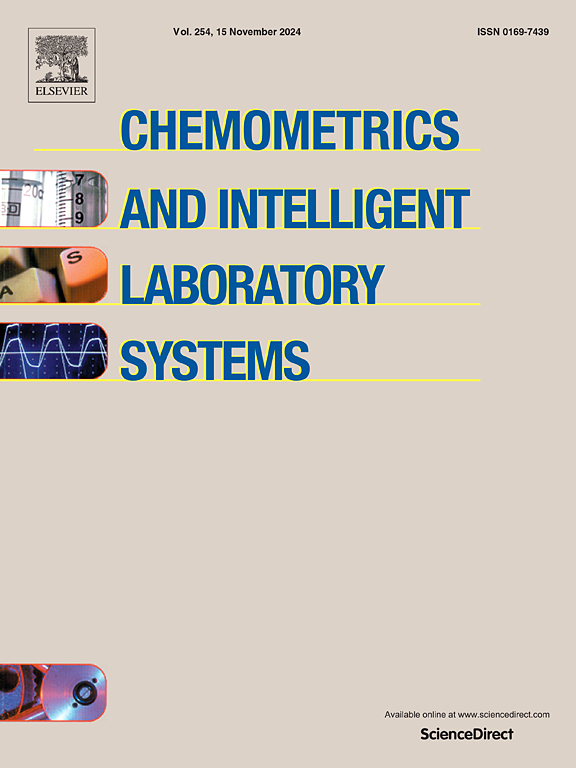水溶液中Cu(II)在功能化材料上吸附机理的化学计量学建模:集成人工神经网络和多孔结构表征
IF 3.8
2区 化学
Q2 AUTOMATION & CONTROL SYSTEMS
Chemometrics and Intelligent Laboratory Systems
Pub Date : 2025-04-15
DOI:10.1016/j.chemolab.2025.105405
引用次数: 0
摘要
评价吸附机理的传统方法依赖于材料的特性及其与吸附量的线性关系。然而,这种方法有局限性,因为它假设了线性相关性,当它失败时,通常会推测涉及多个机制,而没有详细说明它们的贡献。本研究通过使用人工智能分析Cu(II)在替代吸附剂上的吸附,克服了这些挑战。基于压汞孔隙度法,采用人工神经网络(ANN)结合三维孔隙结构模拟,建立了13种孔隙结构、化学特征与吸附容量之间的非线性关系。吸附量最高的材料(107 mg g−1)具有富含-COOH基团的易接近多孔结构。人工神经网络量化了两种控制机制的贡献:通过多孔结构的扩散(67.07%)和与-COOH位点的相互作用(32.93%)。化学计量分析表明,ANN模型中最大的权重归因于平均孔径(17.11%),这与SEM-EDX对饱和材料的表征一致,表明吸附主要发生在材料的暴露腔中。人工神经网络研究提出的吸附机制解释了在不同材料中观察到的非典型点,表明吸附过程由两种机制的组合控制:一种与多孔结构有关,另一种与表面化学有关。研究结果为进一步了解影响吸附的关键因素提供了依据,并为优化材料合成提供了指导。本文章由计算机程序翻译,如有差异,请以英文原文为准。
Chemometric modeling of the adsorption mechanism of Cu(II) in aqueous solution onto functionalized materials: Integrating artificial neural networks and porous structure characterization
Traditional methods for evaluating adsorption mechanisms rely on material characterization and its linear relationship with adsorption capacity. However, this approach has limitations, as it assumes a linear correlation, and when this fails, it is often speculated that multiple mechanisms are involved without detailing their contributions. This study overcomes these challenges by using artificial intelligence to analyze the adsorption of Cu(II) onto alternative adsorbents. An Artificial Neural Network (ANN) combined with 3D porous texture simulations, based on mercury intrusion porosimetry, established non-linear correlations among 13 textural and chemical characteristics and adsorption capacity.
The material with the highest adsorption capacity (107 mg g−1) featured an accessible porous texture rich in –COOH groups. The ANN quantified the contributions of two governing mechanisms: diffusion through the porous texture (67.07 %) and interaction with –COOH sites (32.93 %). Chemometric analysis revealed that the greatest weight in the ANN model was attributed to the average pore diameter (17.11 %), which was consistent with the characterization of the saturated material by SEM-EDX, showing that adsorption occurs primarily in the exposed cavities of the material.
The adsorption mechanism proposed by the ANN study explains the atypical points observed in the different materials, showing that the adsorption process is governed by a combination of two mechanisms: one associated with the porous texture and the other with surface chemistry. The findings provide a deeper understanding of the key variables influencing adsorption and offer guidance for optimizing material synthesis.
求助全文
通过发布文献求助,成功后即可免费获取论文全文。
去求助
来源期刊
CiteScore
7.50
自引率
7.70%
发文量
169
审稿时长
3.4 months
期刊介绍:
Chemometrics and Intelligent Laboratory Systems publishes original research papers, short communications, reviews, tutorials and Original Software Publications reporting on development of novel statistical, mathematical, or computer techniques in Chemistry and related disciplines.
Chemometrics is the chemical discipline that uses mathematical and statistical methods to design or select optimal procedures and experiments, and to provide maximum chemical information by analysing chemical data.
The journal deals with the following topics:
1) Development of new statistical, mathematical and chemometrical methods for Chemistry and related fields (Environmental Chemistry, Biochemistry, Toxicology, System Biology, -Omics, etc.)
2) Novel applications of chemometrics to all branches of Chemistry and related fields (typical domains of interest are: process data analysis, experimental design, data mining, signal processing, supervised modelling, decision making, robust statistics, mixture analysis, multivariate calibration etc.) Routine applications of established chemometrical techniques will not be considered.
3) Development of new software that provides novel tools or truly advances the use of chemometrical methods.
4) Well characterized data sets to test performance for the new methods and software.
The journal complies with International Committee of Medical Journal Editors'' Uniform requirements for manuscripts.

 求助内容:
求助内容: 应助结果提醒方式:
应助结果提醒方式:


